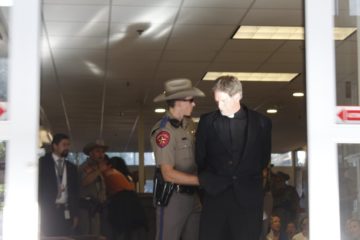A mother and her 11-year-old son won relief from deportation under Obama. But Trump’s ICE took it away.

Two weeks before Donald Trump won the presidency, Hilda Ramirez and her son, Ivan, were all smiles as they announced they’d won a yearlong reprieve from being deported back to Guatemala. For the previous eight months, the two had lived in a tiny converted classroom in a North Austin church while supporters pressured Immigration and Customs Enforcement (ICE) to back off deportation — a tactic known as “sanctuary” that depends on a long-standing ICE policy of avoiding churches.
But on Tuesday, Ramirez announced that ICE had refused to renew their protection in October; once again, she and Ivan, 11, will indefinitely confine themselves in the church.
“I’m grateful that the church is continuing to support me; I don’t feel alone,” said Ramirez Tuesday on a conference call attended by four immigrants living in sanctuary in Texas, Ohio, Pennsylvania and North Carolina. “The church is my family … and I’m going to continue fighting.”
Ramirez, who speaks the Mayan language Mam, fled familial violence with Ivan in 2014, but like 77 percent of Guatemalans, she was denied asylum in the United States. Now she’s one of 34 immigrants openly taking sanctuary in churches around the country, according to the Rev. Noel Anderson of the Church World Service. Under Obama, ICE would often exercise “prosecutorial discretion” by giving temporary relief from deportation to immigrants in sanctuary. As long as they posed no threat, the agency would renew that protection. But activists say Trump’s ICE has been far less lenient, and Ramirez isn’tthe first to be forced into sanctuary a second time.
“We’re under the belief that prosecutorial discretion is now severely limited around the country,” said Alejandro Caceres, an organizer with the Austin Sanctuary Network. ICE spokesperson Matthew Bourke insisted decisions are still made on “a case-by-case basis,” but added that under Trump, “all of those in violation of the immigration laws may be subject to immigration arrest.”
Caceres said his network will research how prosecutorial discretion is being applied around the country, then decide what tactics to use in Ramirez’s case. In the past, they’ve bombarded the San Antonio ICE office with letters, in-person visits and activist caravans. “In the end, it’s not about asking immigration [authorities],” he said. “It’s about demonstrating power, and showing there are consequences on the ground.”

Hilda and Ivan are no strangers to confinement. The pair was detained for 11 months in a South Texas immigration jail while their asylum application and appeal were processed. As with the vast majority of Central Americans, an immigration judge deemed they didn’t meet the strict requirementsof refugee status.
ICE released them from detention in July 2015 only because Ivan potentially qualified for a separate visa and because a federal judge had recently ruled against prolonged detention of children. They then spent seven months at an Austin nonprofit immigrant shelter. When the Obama administration announced its intention to target recently arrived Central Americans, Ramirez made the decision to seek shelter at St. Andrew’s Presbyterian Church.
After winning temporary relief in October 2016, they continued to live in the church but were free to come and go as they pleased. Ivan’s school was close to the church, and Hilda, with little job experience, had trouble finding full-time work in the area, according to friend and sanctuary organizer Sulma Franco. Trump’s election also made Ramirez worry that her reprieve wouldn’t last, said Franco. Ivan’s visa application is still pending, according to Caceres, while Hilda’s path toward permanent legal status is unclear.

“We have the same commitment to them: to Ivan having some kind of a childhood, to the both of them having some kind of a life,” said Jim Rigby, the pastor of St. Andrew’s. “It seems the stakes have gone up [under Trump], but there’s no point really thinking about it. … You do the right thing, and that’s it.”
So far, ICE appears to still regard churches as off-limits, but recent arrests of a sanctuary organizer and the husband of a woman in sanctuary have made some nervous. “We’ve seen an increase in targeting of people involved in sanctuary,” said Ohio activist Rubén Castilla Herrera on Tuesday.
Asked what he would do if ICE ever tried to enter his church, Rigby said, “You don’t know for sure what you’ll do in a situation like that until they’re banging on your door. But my plan isn’t to cooperate; the idea is to be the buffer.”




















0 comments:
Post a Comment
Disclaimer: Opinions expressed in comments are those of the comment writers alone and does not reflect or represent the views of Bright Clement. info call or whatsapp +2348166575765